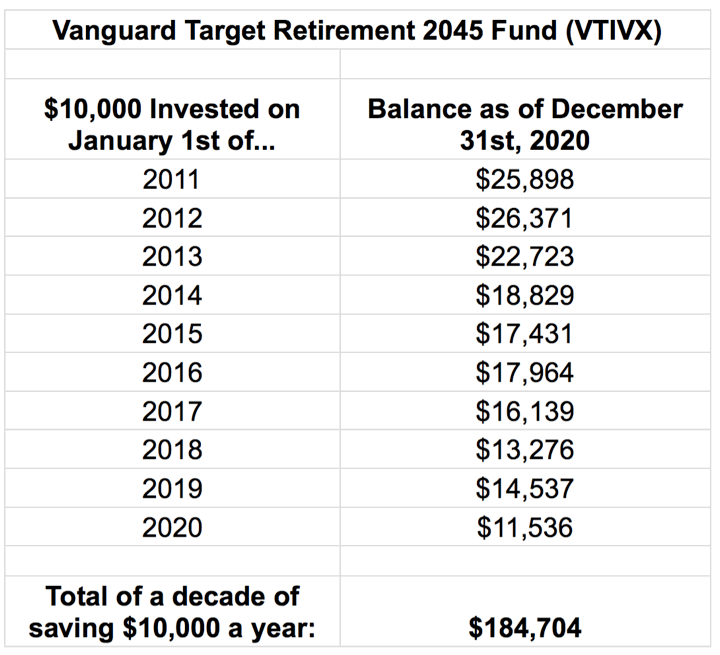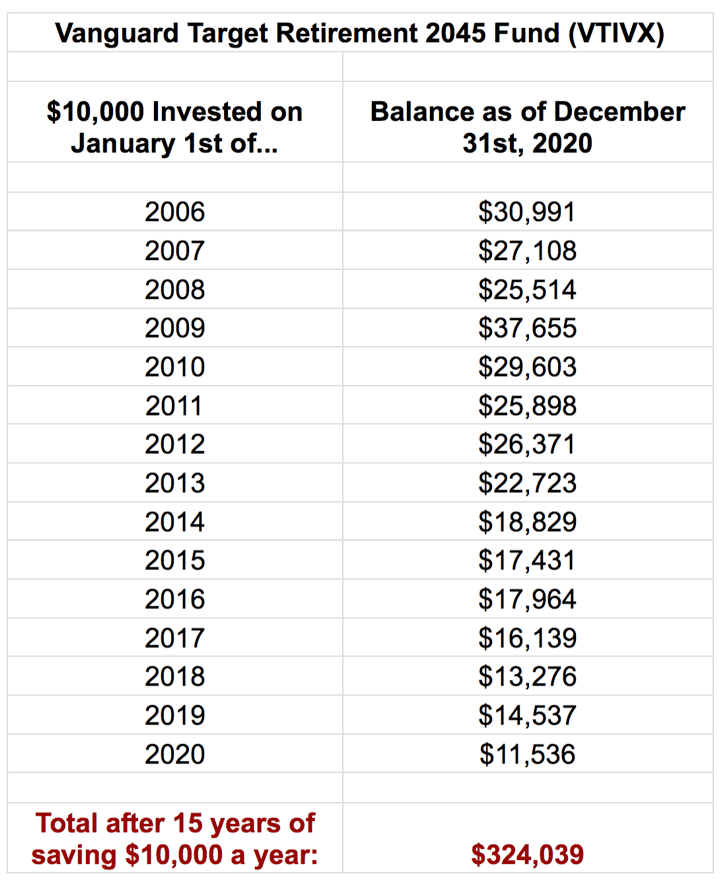 Instead of focusing only on what happened in 2020, how about stepping back and taking the longer view? How would a slow-and-steady investor have done over the last decade? Most successful savers invest money each year over a long period of time, these days often into a target-date fund (TDF). You may not find yourself buying Bugattis with Bitcoin, but we should not take for granted the ability for everyday folks to own a basket of successful businesses for tiny fees. Don’t pass up the opportunity right in front of you.
Instead of focusing only on what happened in 2020, how about stepping back and taking the longer view? How would a slow-and-steady investor have done over the last decade? Most successful savers invest money each year over a long period of time, these days often into a target-date fund (TDF). You may not find yourself buying Bugattis with Bitcoin, but we should not take for granted the ability for everyday folks to own a basket of successful businesses for tiny fees. Don’t pass up the opportunity right in front of you.
Target date funds. The Vanguard Target Retirement 2045 Fund is an all-in-one fund that is low-cost, highly diversified, and available both inside many employer retirement plans and to anyone that funds an IRA. During the early accumulation phase, this fund holds 90% stocks (both US and international) and 10% bonds (investment-grade domestic and international). It is a solid default choice in a world of mediocre, overpriced options. These “simple” funds have made substantial wealth for millions of investors.
The power of consistent, tax-advantaged investing. For the last decade, the maximum allowable annual contribution to a Traditional or Roth IRA has been roughly $5,000 per person. The maximum allowable annual contribution for a 401k, 403b, or TSP plan has been over $10,000 per person. If you have a household income of $67,000, then $10,000 is right at the 15% savings rate mark. Therefore, I’m going to use $10,000 as a benchmark amount. This round number also makes it easy to multiply the results as needed to match your own situation. Save $5,000 a year? Halve the result. Save $20,000 a year? Double the numbers, and so on.
The real-world payoff from a decade of saving $833 a month. What would have happened if you put $10,000 a year into the Vanguard Target Retirement 2045 Fund, every year, for the past 10 years? You’d have put in $100,000 over time, but in more manageable increments. With the interactive tools at Morningstar and a Google spreadsheet, we get this:

Investing $10,000 every year for the last decade would have resulted in a total balance of $184,000. That breaks down to $100k in contributions + $84k investment growth.
Extended edition: 15 years of real-world savings. What would have happened if you put $10,000 a year into the Vanguard Target Retirement 2045 Fund, every year, for the past 15 years instead? (Now $150,000 total.) Here are the extended return numbers:

Investing $10,000 every year for the last decade and a half would have resulted in a total balance of $324,000. That breaks down to $150k in contributions + $175k investment growth. Your gains are now officially more than what you initially invested.
Real-world path to becoming a 401(k) millionaire. Not theoretical numbers from a calculator! Are you a dual-income household that can put away more? If you were a couple that both maxed out their 401k and IRAs at roughly $20k each or $40k total per year for 10 years, you would have a total balance of over $735,000. You would be 3/4 of the way to millionaire status after a decade. That breaks down to $400k in contributions + $335k investment growth.
If you did this for the last 15 years, you would be a 401(k) millionaire household. If you started when you were 30 years old, your account statement would show a balance just shy of $1,300,000 by the age of 45. (This doesn’t include the 401k company match, which is how many people reach millionaire status even faster.)
Timing still matters, but not as much as you might think due to the dollar-cost averaging and longer time horizon. Yes, the last decade has been a great run for US stock markets. But Vanguard Target funds also own a lot of international stocks, which haven’t been nearly as hot and have maintained lower valuations. More importantly, you can’t control that part. You have much more control over how much you save. Here are my previous “saving for a decade” posts:
- 2020 Edition (January 2010 to December 2019)
- 2019 Edition (January 2009 to December 2018)
- 2018 Edition (January 2008 to December 2017)
- 2017 Edition (January 2007 to December 2016)
Work on improving your career skills (or start your own business), save a big chunk of your income, and then invest it in productive assets. Keep calm and repeat. The only “secret” here is consistency. We have maxed out both IRA and the 401k salary deferral limits nearly every year since 2004. No inheritances, no special access to a hedge fund, no stock-picking skill. You can build serious wealth with something as accessible and boring as the Vanguard Target Retirement fund.
 The Best Credit Card Bonus Offers – 2025
The Best Credit Card Bonus Offers – 2025 Big List of Free Stocks from Brokerage Apps
Big List of Free Stocks from Brokerage Apps Best Interest Rates on Cash - 2025
Best Interest Rates on Cash - 2025 Free Credit Scores x 3 + Free Credit Monitoring
Free Credit Scores x 3 + Free Credit Monitoring Best No Fee 0% APR Balance Transfer Offers
Best No Fee 0% APR Balance Transfer Offers Little-Known Cellular Data Plans That Can Save Big Money
Little-Known Cellular Data Plans That Can Save Big Money How To Haggle Your Cable or Direct TV Bill
How To Haggle Your Cable or Direct TV Bill Big List of Free Consumer Data Reports (Credit, Rent, Work)
Big List of Free Consumer Data Reports (Credit, Rent, Work)
I’ve been maxing out my 401k for the last 30 years and now I am over a million.
I think that the 401K is one of the greatest investment vehicles of all times. I’m always amazed when I meet someone who is not putting anything into their 401k or putting very little.
Thanks for sharing. It helps for people to realize it is possible and perhaps more common than they think.
Let me just take this moment to say thank you for these posts. I read something like this way back…maybe 2007? At the time I thought early retirement was a pipe dream, and I was just reading for the credit card award reviews. Anyway – exposure to an idea and normalizing that idea are the first basic steps into making it a reality. Then, I was married no kids. Now, I am married with two kids, living in the country of our choice and semi retired at 40. You were part of that early spark and this headline reminded me of that! Hope your blog continues to inspire people to shoot for the (seemingly) impossible. Being a 401k millionaire isn’t within everyone’s reach, but it is a definite possibility for many!
@OTF – Nice! Thanks for reading and sharing your story. 10+ years can go by fast!
If you’re below the IRA phaseout threshold, 401k + IRA max is $25k per person, not $20k. For example, ~19k in 401k and 6k in (Roth) IRA. Maybe you made some assumptions I did not though.
I was just making a generalization for the previous decade, as the total limit wasn’t yet $25k in 2011. But yes, going forward you can put in even more money.
Shhh. You’ll put all of the financial planners out of business.
Many employers will match some percentage of your 401(k) contributions, so the amounts could go even higher. We need to be cautious though, the next 10 years may not be as fruitful.
It would be super interesting to see how this same analysis changes if you invested semi-annually,monthly, bi-weekly, or even daily (capable with M1).
As long as you are investing the same amount over the same period of time (i.e. $833 a month or ~$40 per open market day), I honestly doubt the results would change very much over the span of a decade.
Thanks Jonathan for showing the big picture !! I really hope more folks see 401K in the way you presented it !! Similar to OTF story, I have been reading you for 10+ years and thank you for the financial knowledge that you have been sharing. I have come back to your blog so many times when I am stuck on something, be it college savings, back door Roth or credit card reviews and am looking for a knowledgeable advice.